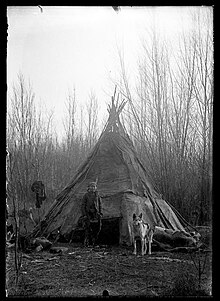Vladimir Jochelson

Vladimir Ilyich Jochelson (
Biography
Jochelson came from a wealthy, religious
In Siberia Jochelson made a special study of the language, manners, and folk-lore of the aboriginal inhabitants, especially that of the
When the

In 1909–11 Jochelson led the Riaboushinsky Expedition of the Imperial Russian Geographic Society to
Jochelson contributed extensively to scientific journals in Russian, German and English. In English his best-known full works are his volumes The Koryaks (1908) and The Yukaghir and Yukaghirized Tungus (1926) for the Jesup Expedition; his handbook Peoples of Asiatic Russia (1928) for the American Museum of Natural History; and Archeological Investigations in the Aleutian Islands (1925) and Archeological Investigations in Kamchatka (1928), both for the Carnegie Institution. His final work focussed on refining his work on the
Works
Further reading
- Alexia Bloch and Laurel Kendall (2004), The Museum at the End of the World: Encounters in the Russian Far East. Philadelphia: University of Pennsylvania Press. ISBN 0-8122-1878-7.
References
![]() This article incorporates text from a publication now in the public domain: Herman Rosenthal and Peter Wiernik (1901–1906). "Jochelson, Waldemar". In Singer, Isidore; et al. (eds.). The Jewish Encyclopedia. New York: Funk & Wagnalls.
This article incorporates text from a publication now in the public domain: Herman Rosenthal and Peter Wiernik (1901–1906). "Jochelson, Waldemar". In Singer, Isidore; et al. (eds.). The Jewish Encyclopedia. New York: Funk & Wagnalls.
- ^ Also: Waldemar Jochelson, Vladimir I. Iochel'son, Vladimir Ilič Iochelʹson
- ISBN 978-0-8147-4213-6. Retrieved August 17, 2009.
- ^ a b c d Jochelson, Waldemar, Jewish Encyclopedia, 1906.
- ^ , pp. 376–77.
- ^ Biographies of the Individuals Associated with the American Museum of Natural History's Jesup North Pacific Expedition Archived 2011-06-04 at the Wayback Machine, American Museum of Natural History. Accessed (via Google cache) 5 July 2011
- ^ Asian Ethnographic Collection at AMNH, American Museum of Natural History. Accessed (via Google cache) 5 July 2011
- ^ a b Waldemar Jochelson papers, 1909-1937, New York Public Library. Accessed 5 July 2011
